ホーム → 文法 → DoJG main menu → 基本 → Basic Page 428
Verb (Irregular)
| Someone/Something causes a state or action to take place. | Do; make; play; play the role of ~; wear |
| 【Related Expression: なる; やる】 |
(ksa). 中山さんはテニスをする・します。
Mr. Nakayama plays tennis.
(ksb). リーズさんは英語の先生をしている・います。
Mr. Leeds is an English teacher.
(ksc). 先生はテストを易しくした・しました。
The teacher made his test easy.
(ksd). 木口は息子を医者にした・しました。
Kiguchi caused his son to become a physician.
(kse). 私は中国語を勉強している・います。
I am studying Chinese.
(ksf). 京子は奇麗なスカーフをしている・います。
Kyoko is wearing a beautiful scarf.
(a). 日本人は大抵土曜日も仕事をする。
The Japanese usually work on Saturdays, too.
(b). ビルはハムレットをするつもりだ。
Bill is going to play Hamlet.
(c). 陽子は部屋を奇麗にした。
Yoko made her room clean.
(d). 僕はよく車を運転します。
I often drive a car.
(e). 一男はアメリカ人を妻にした。
Kazuo made a wife of an American.
(f). いいネクタイをしているね。
You're wearing a nice tie, aren't you?
1. する1 means 'to cause some state or action', and corresponds to English 'do' or 'make'.
2. Key Sentence (A) and Example (a) are cases in which the subject is doing/playing something Key Sentence (B) as well as Example (b) are cases where the subject is playing a social or dramatic role. Key sentence (C) and (D) and Example (c) have causative meanings.
3. Key Sentence (C) and Example (c) require that either Adjective い stem+く or Adjective な stem+に (i.e., adverbial form of Adjective (い/な) be used before する. Key Sentence (D) and Example (e) use a Noun+に in front of する.
4. The Direct Objects of Key Sentence (F) and Example (f) are items that cover a small part of the human body such as ネクタイ '(neck)tie', 手袋 'gloves' and 腕時計 'wristwatch'. When used with such direct objects, する means 'wear'.
5. The construction in Key Sentence (D) (i.e., Noun+にする) also has an idiomatic use, meaning 'decide on ~'.
(⇨ にする)
6. Sino-Japanese compounds+する such as 勉強する 'study' and 運転する 'drive' can be used as transitive verbs, as in Key Sentence (E) and Example (d). The Sino-Japanese compound itself can also be used as the direct object of する. For example, compare Key Sentence (E) and Example (d) with (1) and (2), respectively.
Note in Sentences (1) and (2) that the direct object in Key Sentence (E) and Example (d) is connected to the Sino-Japanese compound by the particle の, creating a noun phrase which is the direct object of する.
7. In contemporary Japanese it is very common to use する with loanwords. The majority of loanwords are from English verbs. Some typical examples follow:
| ヒットする | make a hit | ノックする | knock on the door |
| ドライブする | drive a car | キスする | kiss |
| タイプする | type | パスする | pass an exam |
It is also common to use する with sound symbolisms, especially phenomimes and psychomimes.
| びくびくする | be in fear | かっとする | flare up |
| ぼんやりする | be absent-minded | はっとする | be taken aback |
| ぞっとする | shiver | いらいらする | become irritated |
8. する basically means some causative change that is under human control, whereas なる 'become' basically means spontaneous change that is almost beyond human control. Since injury normally occurs due to human carelessness, する is acceptable, but なる is unacceptable, as shown in below. In contrast to injury, illness is assumed to occur regardless of human carefulness or carelessness, so it should not take する. But in actuality it does. Illness can take する when it is talked about as if it were something under human control, for example, cases of past illness (as in (4a)), apologies implying that one has caused illness due to carelessness on one's part (as in (4b)), and statements of one's medical history (as in (4c)). Otherwise, illness cannot take する, as shown in (4d).
9. する can be used in the construction を+Verbます+する, a humble, polite form of verb. The subject of this humble verb must be the speaker or his in-group member.
A further degree of humbleness can be expressed by replacing する with its humble version いたす/いたします.
(⇨ お~する)
【Related Expressions】
I. なる 'become' forms an intransitive-transitive pair with する, although they are not phonetically related. Semantically, なる seems more passive, while する seems more causative. Compare the following pairs of sentences:
[1]
[2]
II. する can be replaced by its informal version やる (Group 1 Verb) when it means 'do/play something' as in Key Sentence (A) or 'play a dramatic/social role' as in Key Sentence (B). Also, if する takes a Sino-Japanese compound as its direct object (as in 勉強をする 'Literally: do a study of'), it can be replaced by やる.